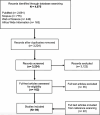Incorporating social vulnerability in infectious disease mathematical modelling: a scoping review
- PMID: 38500147
- PMCID: PMC10949739
- DOI: 10.1186/s12916-024-03333-y
Incorporating social vulnerability in infectious disease mathematical modelling: a scoping review
Abstract
Background: Highlighted by the rise of COVID-19, climate change, and conflict, socially vulnerable populations are least resilient to disaster. In infectious disease management, mathematical models are a commonly used tool. Researchers should include social vulnerability in models to strengthen their utility in reflecting real-world dynamics. We conducted a scoping review to evaluate how researchers have incorporated social vulnerability into infectious disease mathematical models.
Methods: The methodology followed the Joanna Briggs Institute and updated Arksey and O'Malley frameworks, verified by the PRISMA-ScR checklist. PubMed, Clarivate Web of Science, Scopus, EBSCO Africa Wide Information, and Cochrane Library were systematically searched for peer-reviewed published articles. Screening and extracting data were done by two independent researchers.
Results: Of 4075 results, 89 articles were identified. Two-thirds of articles used a compartmental model (n = 58, 65.2%), with a quarter using agent-based models (n = 24, 27.0%). Overall, routine indicators, namely age and sex, were among the most frequently used measures (n = 42, 12.3%; n = 22, 6.4%, respectively). Only one measure related to culture and social behaviour (0.3%). For compartmental models, researchers commonly constructed distinct models for each level of a social vulnerability measure and included new parameters or influenced standard parameters in model equations (n = 30, 51.7%). For all agent-based models, characteristics were assigned to hosts (n = 24, 100.0%), with most models including age, contact behaviour, and/or sex (n = 18, 75.0%; n = 14, 53.3%; n = 10, 41.7%, respectively).
Conclusions: Given the importance of equitable and effective infectious disease management, there is potential to further the field. Our findings demonstrate that social vulnerability is not considered holistically. There is a focus on incorporating routine demographic indicators but important cultural and social behaviours that impact health outcomes are excluded. It is crucial to develop models that foreground social vulnerability to not only design more equitable interventions, but also to develop more effective infectious disease control and elimination strategies. Furthermore, this study revealed the lack of transparency around data sources, inconsistent reporting, lack of collaboration with local experts, and limited studies focused on modelling cultural indicators. These challenges are priorities for future research.
Keywords: Global health; Health disparities; Health equity; Health inequalities; Infectious disease; Mathematical modelling; Social determinants of health; Social vulnerability.
© 2024. The Author(s).
Conflict of interest statement
The authors declare that they have no competing interests.
Figures









References
-
- Gray A, Sharara F. Global and regional sepsis and infectious syndrome mortality in 2019: a systematic analysis. Lancet Glob Health. 2022;10(Special Issue). Doi:10.1016/S2214-109X(22)00131-0
Publication types
MeSH terms
Grants and funding
LinkOut - more resources
Full Text Sources
Medical

